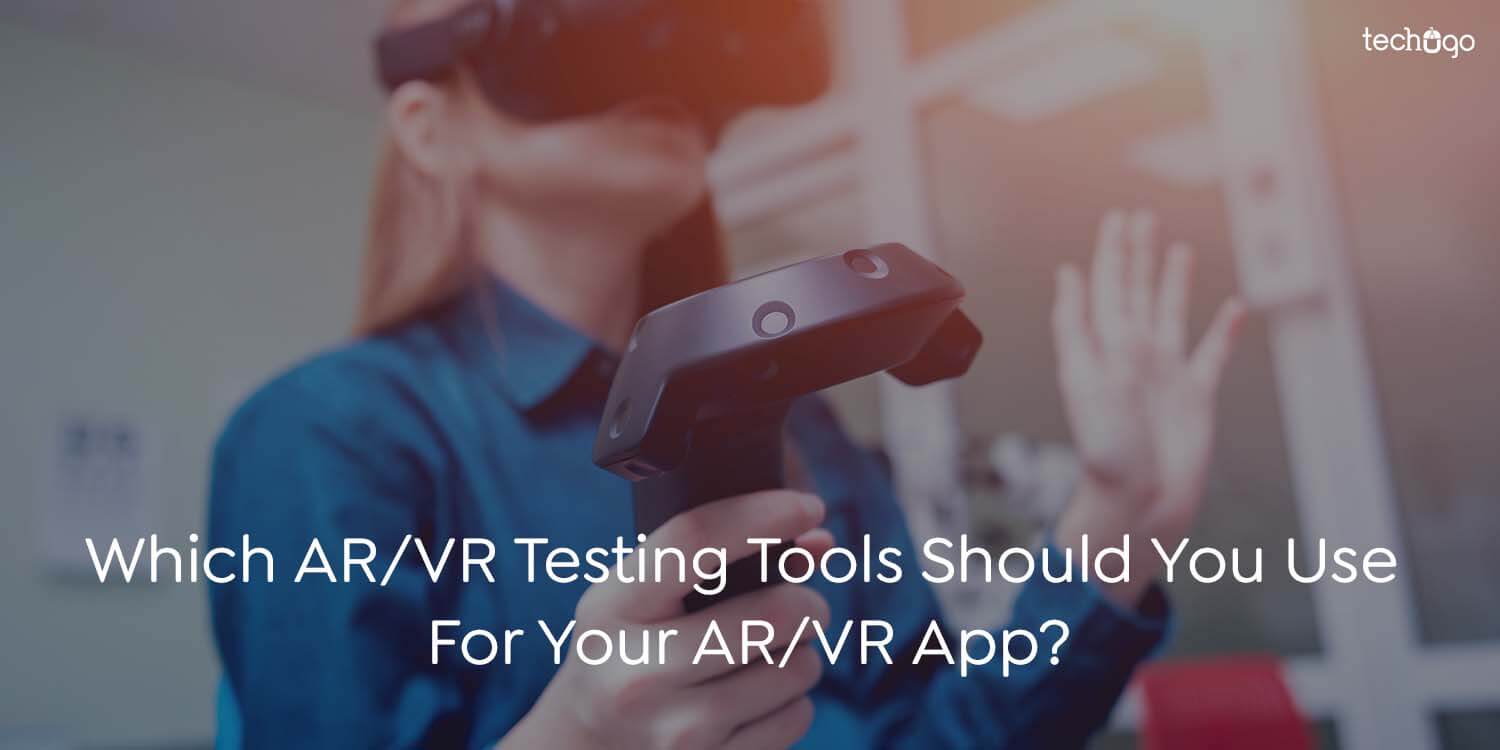29 Dec 2022
Which AR/VR Testing Tools Should You Use For Your AR/VR App?
Shivani Singh

Augmented or virtual Reality can be reality technologies that enhance or replace real-life environments with simulated ones. It augments your environment by adding digital elements into a live view using a smartphone’s camera. AR is a virtual environment that can coexist with the real world. Its goal is to be informative and provide a digital experience to its real user. When the user directs the device at an item of equipment failing, AR apps for industrial use could provide instant troubleshooting assistance.
Virtual Reality (VR) provides an immersive experience via replacing reality with a virtual world. It is a simulation of the environment that completely replaces the real world and brings in digital quality. These virtual environments are often larger than real life because they are entirely fabricated. For example, VR allows users to box in virtual Reality with the cartoon Mike Tyson.
Although both Virtual Reality and Augmented Reality can create a realistic environment for the user, each concept has its unique use case. For example, businesses are increasingly using augmented Reality for entertainment purposes. As a result, it can generate overlays of information that add value to real-world scenarios.
In the sections below, we’ll explore the definition of these technologies and how they differ from others.
What is Augmented Reality?
Augmented Reality (AR) is a new way of experiencing the digital world. It combines real and digital elements and is equally applicable to desktops and mobile devices. Its unique characteristic is its ability to reflect digital components in the real world that create unique customer experiences.
What is Virtual Reality?
AR is a computer-generated simulation, while VR is a way to create an alternate world.
You can fully immerse yourself in the digital world with the proper hardware. However, there are some key differences between VR headsets, AR headsets, and both. VR hardware needs sensory devices that can convert real-world movements into a modeled world.
Virtual Reality and Augmented Reality? What’s the Difference?
There are critical differences between AR and VR. However, this does not mean that one technology is better. Both technologies work equally well in different applications.
- VR creates an immersive virtual world, while AR enhances real-world scenes.
- VR is 75% virtual, AR is 25% virtual
- AR does not require a headset. VR does.
- AR users can interact directly with the real world, while VR users travel to a fictional world.
- AR requires more bandwidth than VR.
- AR enhances the real and virtual worlds, while VR replaces the real and improves games.
Now that you have developed a complete insight into their differences, it’s time to move further and learn about AR/VR testing.
What is AR/VR testing?
AR/VR testing covers compatibility and full-stack functionality. It also takes into account security and usability. Maintainability, performance, and a new factor called “Immersiveness” are all critical. AR/VR is a new way to combine virtual and physical worlds. The user must experience this immersive experience. Therefore, it is crucial to ensure the user has a great experience.
AR/VR can cause motion sickness, seizures, or headaches because it is fully immersive. We at Techugo identify such issues during software testing. The goal of the app development team is to create an immersive experience. Keeping that in mind, the testing team works hard to optimize the experience and minimize discomfort.
Challenges Appear with AR/VR Testing
1. Non-standard interfaces and 3D space
GUI testing checklists include essential elements like a menu, icon, window, and pointing device. However, augmented reality testing enable users to interact with the app using many methods, rendering traditional usability testing inefficient.
This problem has been a focus of research groups for some time.
They are working to create new standards for GUI and usability testing, reflecting the multidimensional relationships between the virtual world and Augmented Reality. Right now, there are many AR apps that one must test. Therefore, testing engineers will need to develop their heuristics for the moment.
Our Quality and Assurance team recommends starting with reading relevant research papers. This checklist helps in verifying AR applications’ usability. You can use this checklist to create your customized option for a particular QA project.
2. Motion Testing
Motion testing involves overlaying digital data onto an image that shows real-world motion. This means that movements and rotations from the smartphone’s physical camera must be translated into its virtual representation.
Although it sounds simple, it’s pretty tricky. However, we can use the gyroscope. AR applications often have motion testing issues. Therefore, checking for augmented objects that begin floating from their intended positions when the device moves in unexpected ways is vital.
3. Legal Implications
A comprehensive legal framework does not cover AR application testing. So, it is vital to establish AR applications’ physical nature and interaction to protect privacy. Data privacy is an urgent legal issue as the world becomes more digitalized. Cybercrime is on the rise, while the legal implications of this industry are still not clear. That makes it a significant concern as it develops.
4. Additional Testing Requirements
The testers ensure that the application runs smoothly and there are no apparent bugs. They might also have to verify that the application accurately depicts Reality. This is especially important for VR headsets and more so for the testers than the developers. Testing an augmented reality app will be more complex than any other web or mobile app.
As there is a physical component, testers will need to be able to see how movement affects user experience. Engineers may also be interested in the device’s accessibility for people with motion sickness or the disabled.
Tools to analyze to test AR/VR Apps
Here are some dynamic AR/VR testing tools that let you test your VR apps.
OVR Metrics Tools: It uses real-time graphics overlay to analyze the mobile application. It provides data on heat, frame rates, and GPU/CPU throttle value.
Logcat: Logcat can collect VrApi Logs and gather system logs via its command line. The Quality assurance team can check the app’s performance.
Ovrgupprofiler: This tool gives you real-time access to the GPU pipeline metrics, stage trace, and CLI tool support.
GPUsystrace. Moreover, it contains data on the rendering stages.
RenderDoc: One of the most powerful tools for analysing and capturing frames. You can use it to debug graphics with multiple development platforms or graphical APIs.
Unity Profiler: It monitors various aspects of your app’s performance. It can store 300 frames and provide detailed information about each frame.
With the use of these tools, you can get the answer on how to test virtual reality applications.
Also Read: Testing Phase Is A Stepping Milestone For Your App’s Success
How to test your AR/VR applications?
To provide a seamless experience to your end users, you must test your VR/AR applications. But, the question is how to test augmented reality applications.
Don’t be worried! We have the answer here.
Step 1: Learn about the requirements.
This section will allow us to gather all the data about the design and functionality of the application. Moreover, it lets you know the product’s purpose and goals which you convert into epics or user stories to classify the product further.
You will then use the storyboard to extract use cases. This would enable our QA engineers to understand all possible user interaction scenarios and provide a more comprehensive overview of AR/VR applications than just reviewing the capabilities.
This phase allows you to understand the purpose of the application thoroughly. Even the most minor bug can cause problems in the user experience. There, you must take the support of the QA team to test the application and create robust test suites.
Step 2: Test Initialization
You can make the most of test initialization with a solid test set and the correct number of cases. We can determine which priority is best by analyzing the various conditions under which the software is being used.
You should ensure that the test plan covers all devices and lists the products you will use to support it. Next, find out about the test environment and how to set it up.
Step 3: Scope for Testing
This allows us to track the object and verify that our application has registered it. You can use multiple inputs to test the application’s performance and extract the test data. Verify that AR/VR models redirect you to the correct data.
Check the GUI to understand and fix any problems. Once this information is documented, it’s possible to get a clear insight into the scope of the project and our expectations.
Step 4: Select the type of testing you want.
Multiple testing methods, including immersive, functional, and usability testing, are needed to test AR/VR applications to ensure more excellent coverage.
Here is where you must adapt our test strategy to the project. To give you a complete insight into the type of testing, we have prepared a separate section for this. Again, our expertise will ensure that the application meets all industry standards.
Step 5: Work with developers.
You will get the assistance of developers who use cutting-edge technologies. This could allow you to develop a robust product with dynamic technologies that will benefit the project.
Consult our developers to understand better how we will help you in AR/VR testing.
Step 6: A Pinch of Creativity
AR/VR technology has been around for a while. However, as the technologies are very young, it’s not easy to test them and tie them down to any specific functionality.
The best solution is to find creative solutions. You can also try the simple trial-and-error approach with domain experts, senior testers, or business professionals.
Also Read: How Augmented Reality Apps Are Transforming The Learning Experiences?
Different Types of AR/VR Testing
Functional Testing: Design, implementation, and exploratory testing according to the business or practicality, all while fully integrating the AUT.
Pre-production Testing: Pre-production testing is necessary to ensure that the use case meets the preferences and needs of your target audience. In addition, group testing is a helpful way to gather feedback on usability and user interaction.
VR immersion Testing: It requires a particular hardware device. Therefore, we must ensure that the device works with all software to simulate successfully.
Hardware Testing: Understanding and testing the physical environment for AR/VR apps’ intended audience.
Accessibility Testing: It ensures that the AR/VR app is accessible for all users, regardless of age or physical condition. Also, it reduces discomfort and natural navigation.
Compatibility Tests: Your AR/VR app will work seamlessly on all platforms, devices, and consoles. Also, we verify that your AR/VR app provides users with equal visual and sensory opportunities.
Manual Testing: You can test your AR/VR app from a human viewpoint under different conditions. Also, make sure to review the documentation. Our manual testers can identify critical bugs before users.
Security Testing- AR/VR apps have many uses. The military uses these simulators to train soldiers to compromise national security if it is stolen. Security testing is essential to identify any data loss or privacy risks.
Benefits of AR/VR Testing with Techugo on your business:
Some tremendous benefits AR/VR testing with Techugo can provide are:
- Functional Testing: We will help you find qualified QA testers to perform exploratory tests and test case executions that will fully integrate into your SDLC release.
- Pre-production Testing: Work with testers that match your target audience to determine whether AR or VR use case suits them. Get actionable feedback about how users interact with your technology.
- Hardware Testing: VR needs a separate hardware component to function. Leverage Techugo’s network for testing to ensure that the device is functional, compatible with other software, and fits your target audience.
- Immersive Testing: See if your VR causes motion sickness or is too immersive. Techugo can offer suggestions about the physical environment. A VR user might want to know how much space is needed around them. And we will help them get this insight.
- Holistic Testing Approach: Our clients love working with us because we are experts at real-world testing. Testing new technologies such as virtual reality and augmented reality requires the human element to be present, which is often the most challenging part. However, it is easy to work with the human factor when you have the support of the high-graded QA team of Techugo.
Test Virtual Reality and Augmented Reality: Special Consideration to Take!
One of the critical points for testing an AR or VR application is that you have to have a physical environment to test.
Think about tasks you’d have to complete to set up tests. Ensure that the database is in good condition before starting testing. Also, consider using access controls and the space in which you will be testing.
You must print markers for augmented reality in a production environment.
Test for motion sickness
Considering the user’s feelings while using the app or virtual reality gaming is essential.
VR can cause motion sickness. Your eyes may see movement, but your body won’t feel it. This could lead to virtual reality motion sick.
It happens the same way when you are on a boat. However, different people experience different levels and types of motion sickness.
Practical Virtual Reality Testing Advice
Be sure to align yourself with AR/VR developers. The technology is still new, so testers require to collaborate with developers. Luckily, Techugo is a team of developers and QA experts, so you would be fine and even virtual reality testing move seamlessly.
The best way to explore is to get your hands dirty. So get in touch with us today if you want to create an AR/VR experience. It will be up and running no matter how fast you are.
This exercise will give you valuable insights into the creation of these apps and offer suggestions for testing them.
To Sum it Up!
Augmented Reality (VR) and Virtual Reality (AR) are rapidly growing technologies. Validation of these applications is essential. It is crucial to understand how and what tests you should perform.
AR/VR applications have unique requirements regarding tool selection, test scope, and automation, as well as test scenario design. However, with proper planning, these can be met.
Ensure to do AR/VR application testing while collaborating with the Techugo team, which includes UX designers, software engineers, and project managers. To develop and execute a successful testing program, you must understand the application’s limitations, features, expected outcomes, expectations, and other requirements. Luckily, you can quickly learn with our support and assistance. So, get in touch today.
FAQs
1. Can you explain some examples of AR/VR use cases?
Various industries have adopted AR/VR; here are some examples of their use cases.
Nike, with AR, lets its customers determine their shoe size in just seconds.
Sephora is a brand that sells makeup. It has created a virtual environment where users can test lipsticks, shades, and other types of makeup.
Pilots, firefighters, and soldiers can have trained with AR/VR tools.
2. I want to test AR/VR applications. Can you tell me the procedure?
Here are the stages you need to understand to test AR/VR ap
- There have been many trials and a lot of failures. It can often take a lot of subjective effort to find bugs in an app and see how they interact with Reality.
- Recording sessions allow you to gain an outside perspective and a fresh view of problems.
- Automated testing tools can automate both UI and performance tests.
- It is best to test the app under different conditions to get around the problem.
- You can also figure out how reality changes can cause different levels of motion sickness.
- Different AR camera capabilities can mean other interactions between devices. It is crucial to test every option.
- Your feedback reporting tool should be one of your most valuable tools crucial for testing and post-release. It allows users and testers alike to report bugs and give feedback.
3. What are the Tools for Functional Testing of Virtual Reality Applications?
There are several tools you’ll need for virtual reality test. These tools include:
- SteamVR Performance Tool: It is a vital tool for evaluating compatibility. It displays the compatibility of your computer with the VR app.
- 3600 EYETRACKERTM software: The software monitors eye movements to allow you to see all environments. The software enables users to see their point of view and the direction they are looking. The software expands the user’s perspective.
- Unity Testing Tool: Unity is a great way to start. This tool allows you to focus on one object within your virtual world and test unit functionality. Google Instant Preview with Unity is also available via the plugin google. You can view the building unity in the editor using this plugin. This plugin allows you to run your game directly and is visible to everyone around you.
Get in touch.
Write Us
sales@techugo.comOr fill this form



